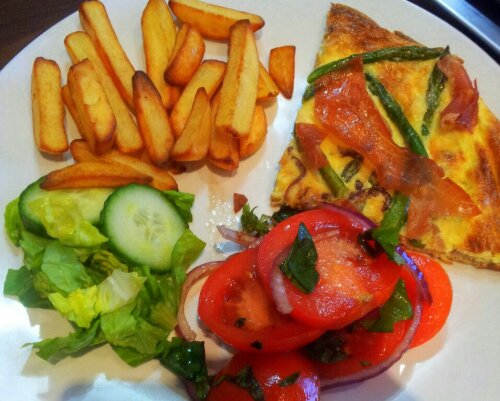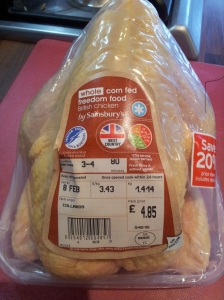In part 1, I discussed how to joint a chicken and roast the crown and make gravy. Now in Part 2, I will show you how I use up the remaining chicken to make a healthy chicken casserole and stock for a soup.
4. Skin and bone the remaining chicken
Although this seems like a lot of effort, there is a lot of fat in and just under the skin of the chicken, and of course, plenty of flavour in those bones. It might take you a while the first few times you do this, but you can soon get it down to a fine art. If I am not in a rush, I actually find butchery quite therapeutic! If I was barbecuing the chicken, then I’d probably leave all this, but since it’s months before it’ll be barbecue weather in the UK, what I want is a warming and filling casserole that won’t blow the daily calorie budget.
Back to the recipe. You will need a sharp knife, a large pan for the bones and and bin bag for the skin. Remember, what we have left – 2 legs, 2 wings and the carcass from underneath the crown. Get the carcass out of the way first. Pull off all the skin. Use a small sharp knife to cut off any large bits of fat. Break the carcass in half using your hands and add it to your stock pot.
Pulling the skin off the legs is fairly easy. Chop the end of the leg of first at the ankle joint (see video) and discard. Start at the top of the thigh, get your fingers under the skin and pull it away from the meat, then gripping it tightly, pull it all the way down the leg and off the bottom. You’ll see bits of fat remaining on the leg, so cut these off too. Now, feel for the knee joint and break it using your hands and then cut the thigh from the drumstick using a knife.
Removing the bones is fairly tricky, but you don’t have to do it with butcher like skill, just get it out as cleanly as possible. Run your knife along the thigh bone, then cut around the joint at one end and separate. Keep running the knife around the bone and turn the thigh on it’s end. You can almost ‘push’ the meat of the bone with knife, keeping it as close to the bone as possible. Then cut around the joint at the other end and chuck the bone in the stock pot.
It’s a similar process for the drumstick, but just be careful – there is a hard tendon right under the bone which needs removing too. There are other tendons in the drumstick, but they should be okay left in and soften up when cooked.
I wouldn’t recommend boning the wings – there’ll hardly be any meat left if you try! Cut off and discard the wingtip – like the end of the legs, it’s mostly fat and gristle. Pull off as much skin as you can and then use your knife to remove any remaining fat and skin. This is what you should be left with:

5. Moroccan Style Chicken Casserole with couscous
This recipe is somewhat adapted from Keith Floyd’s recipe “Floyd’s Cous Cous” from his book Flash Floyd. This is a lovely, lightly flavoured casserole which is very versatile and each to alter depending upon what veg you have in. This will serve 3-4 adults or 2 adults and 2 children.
Read the rest of this entry »









Processed meat gives you cancer, but then so does everything else…
13 03 2013As a writer of a health blog, last week’s main health story really caught my attention. In case you missed it (and it may have just only been news in the UK) here is it in all its glory:
http://www.bbc.co.uk/news/health-21682779
Processed meat ‘early death’ link
To summarise – eating too much processed meat has been linked to early death rates and overconsumption of red meat (fresh or processed) is thought to increase the risks of contracting bowel cancer or cardiovascular/heart disease. It’s a complicated set of results that is a statistical analysis of a huge data set over a long period of time. It is important to note that it is not a medical analysis in that the actual link between the chemical make-up of processed meat and the body’s reaction to it, has not been found. It is thought that the salt and preservatives used in processed meat is the likely culprit.
There’s also a really nice commentary by one of my favourite bloggers here:
http://kelliesfoodtoglow.com/2013/03/07/thoughts-on-meat-plus-honey-miso-roasted-broccoli-and-wholegrains-salad/
In fact, I was going to reply to Kellie on her blog, but thought it was actually rather impolite to hijack her blog with my opinions (not that they differ much).
I should say at this point that this isn’t even new news as such:
http://blogs.webmd.com/health-ehome/2010/11/do-you-eat-processed-meats.html
As a parent and as an adult trying to live a healthier lifestyle, this story, whilst not a complete bolt out of the blue, is fairly shocking, not least of all because I am pretty sure that I, and possibly my children too, consume more than the recommended amount of processed or red meat some weeks. Certainly in the past, I know I have – I’ve had a ham sandwich every day at work some weeks and then tucked into a large plate of Chilli on an evening.
Read the rest of this entry »
Comments : 6 Comments »
Tags: comment, healthy eating, processed meat
Categories : Food information